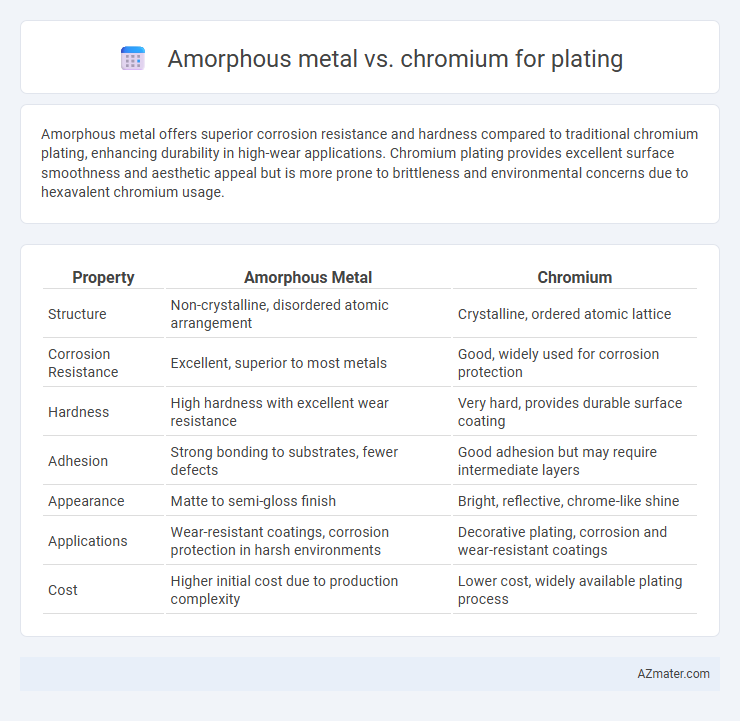Amorphous metal offers superior corrosion resistance and hardness compared to traditional chromium plating, enhancing durability in high-wear applications. Chromium plating provides excellent surface smoothness and aesthetic appeal but is more prone to brittleness and environmental concerns due to hexavalent chromium usage.
Table of Comparison
| Property | Amorphous Metal | Chromium |
|---|---|---|
| Structure | Non-crystalline, disordered atomic arrangement | Crystalline, ordered atomic lattice |
| Corrosion Resistance | Excellent, superior to most metals | Good, widely used for corrosion protection |
| Hardness | High hardness with excellent wear resistance | Very hard, provides durable surface coating |
| Adhesion | Strong bonding to substrates, fewer defects | Good adhesion but may require intermediate layers |
| Appearance | Matte to semi-gloss finish | Bright, reflective, chrome-like shine |
| Applications | Wear-resistant coatings, corrosion protection in harsh environments | Decorative plating, corrosion and wear-resistant coatings |
| Cost | Higher initial cost due to production complexity | Lower cost, widely available plating process |
Introduction: Amorphous Metal vs Chromium Plating
Amorphous metal plating offers superior corrosion resistance and enhanced hardness compared to traditional chromium plating, making it ideal for demanding industrial applications. Chromium plating provides excellent wear resistance and a bright, decorative finish but often suffers from environmental concerns due to toxic hexavalent chromium compounds. The unique atomic structure of amorphous metals eliminates grain boundaries, resulting in improved durability and reduced susceptibility to cracking over conventional chromium coatings.
Composition and Structure Differences
Amorphous metals exhibit a non-crystalline, disordered atomic structure with a composition typically rich in transition metals like zirconium, nickel, or iron, resulting in unique mechanical properties and high corrosion resistance. Chromium plating consists of a crystalline, hexagonal close-packed structure primarily composed of pure chromium or chromium alloys, offering hardness and a reflective finish. The fundamental difference lies in the atomic arrangement: amorphous metals lack grain boundaries, enhancing wear resistance, whereas chromium's crystalline structure provides superior surface hardness and oxidation resistance.
Plating Processes and Techniques
Amorphous metal plating utilizes advanced sputtering and electroplating techniques to achieve a uniform, non-crystalline coating with high hardness and corrosion resistance, enhancing wear properties on industrial components. Chromium plating, often applied through hexavalent or trivalent electroplating processes, provides a robust, shiny finish renowned for its hardness and decorative appeal but may involve environmental and health considerations due to toxic chemicals. Both plating techniques demand precise control over current density, bath composition, and temperature to optimize adhesion, layer thickness, and surface quality for specific application requirements.
Corrosion Resistance Comparison
Amorphous metal coatings exhibit superior corrosion resistance compared to chromium plating due to their non-crystalline atomic structure that lacks grain boundaries, preventing corrosion initiation points. Chromium plating, while offering good hardness and wear resistance, is more prone to pitting and localized corrosion in aggressive environments because of its microcrystalline surface. Studies show amorphous metals maintain integrity longer in saline and acidic conditions, making them ideal for severe corrosion protection applications.
Mechanical Strength and Hardness
Amorphous metal coatings exhibit superior mechanical strength and hardness compared to chromium plating due to their non-crystalline atomic structure, which eliminates grain boundaries and enhances wear resistance. Chromium plating, while traditionally valued for its hardness and corrosion resistance, tends to be more brittle and prone to crack formation under mechanical stress. The unique microstructure of amorphous metals delivers increased durability and longer service life in high-impact and abrasive environments.
Environmental Impact and Safety
Amorphous metal coatings offer superior environmental benefits by reducing waste and energy consumption during plating due to their simpler electrochemical processes compared to traditional chromium plating, which involves toxic hexavalent chromium compounds posing significant health and ecological risks. Chromium plating releases harmful carcinogens and heavy metals into air and water, necessitating strict regulatory controls and costly waste treatment solutions. Amorphous metals enhance workplace safety by eliminating exposure to hazardous chromium fumes, aligning with environmentally sustainable manufacturing practices.
Cost Analysis and Economic Factors
Amorphous metal plating typically incurs higher initial costs due to advanced manufacturing processes and material scarcity compared to chromium plating, which benefits from established, cost-efficient production techniques. Chromium plating offers lower operational expenses and easier scalability, making it economically favorable for large-scale industrial applications. However, the superior corrosion resistance and durability of amorphous metals can reduce long-term maintenance and replacement costs, potentially offsetting higher upfront investments in specific high-performance sectors.
Longevity and Maintenance Requirements
Amorphous metal coatings exhibit superior longevity compared to traditional chromium plating due to their non-crystalline structure, which resists wear, corrosion, and fatigue more effectively. Maintenance requirements for amorphous metals are generally lower since these coatings maintain surface integrity without frequent reapplication or polishing, unlike chromium which can develop pits and cracks over time. The enhanced durability of amorphous metal plating reduces downtime and extends service life, making it a cost-efficient alternative for industrial applications demanding long-term protection.
Applications Across Industries
Amorphous metal plating offers superior corrosion resistance and enhanced wear properties, making it ideal for aerospace components, medical devices, and electronics where durability and precision are critical. Chromium plating is widely used in automotive parts, plumbing fixtures, and decorative hardware due to its hardness, high gloss finish, and excellent corrosion resistance. Both materials serve distinct industrial applications, with amorphous metals excelling in high-performance environments and chromium favored for cost-effective, aesthetic surface protection.
Future Trends in Plating Technology
Amorphous metal coatings demonstrate superior corrosion resistance and wear properties compared to traditional chromium plating, positioning them as a leading candidate for next-generation surface protection. Advances in nano-structured amorphous alloys enable thinner, more uniform layers that reduce environmental impact by minimizing hazardous waste associated with hexavalent chromium processes. Emerging electroplating techniques and additive manufacturing integration forecast a shift toward sustainable, high-performance coatings driven by regulatory pressure and industrial demand for durability and eco-friendly solutions.

Infographic: Amorphous metal vs Chromium for Plating
 azmater.com
azmater.com